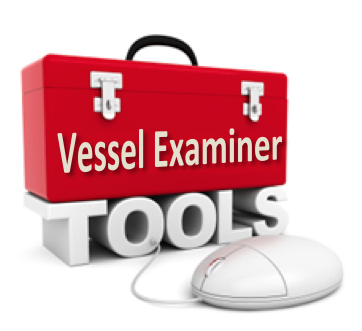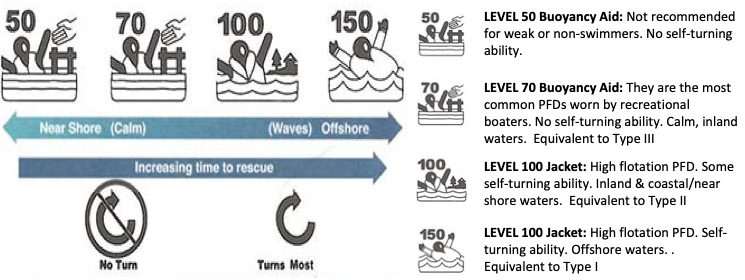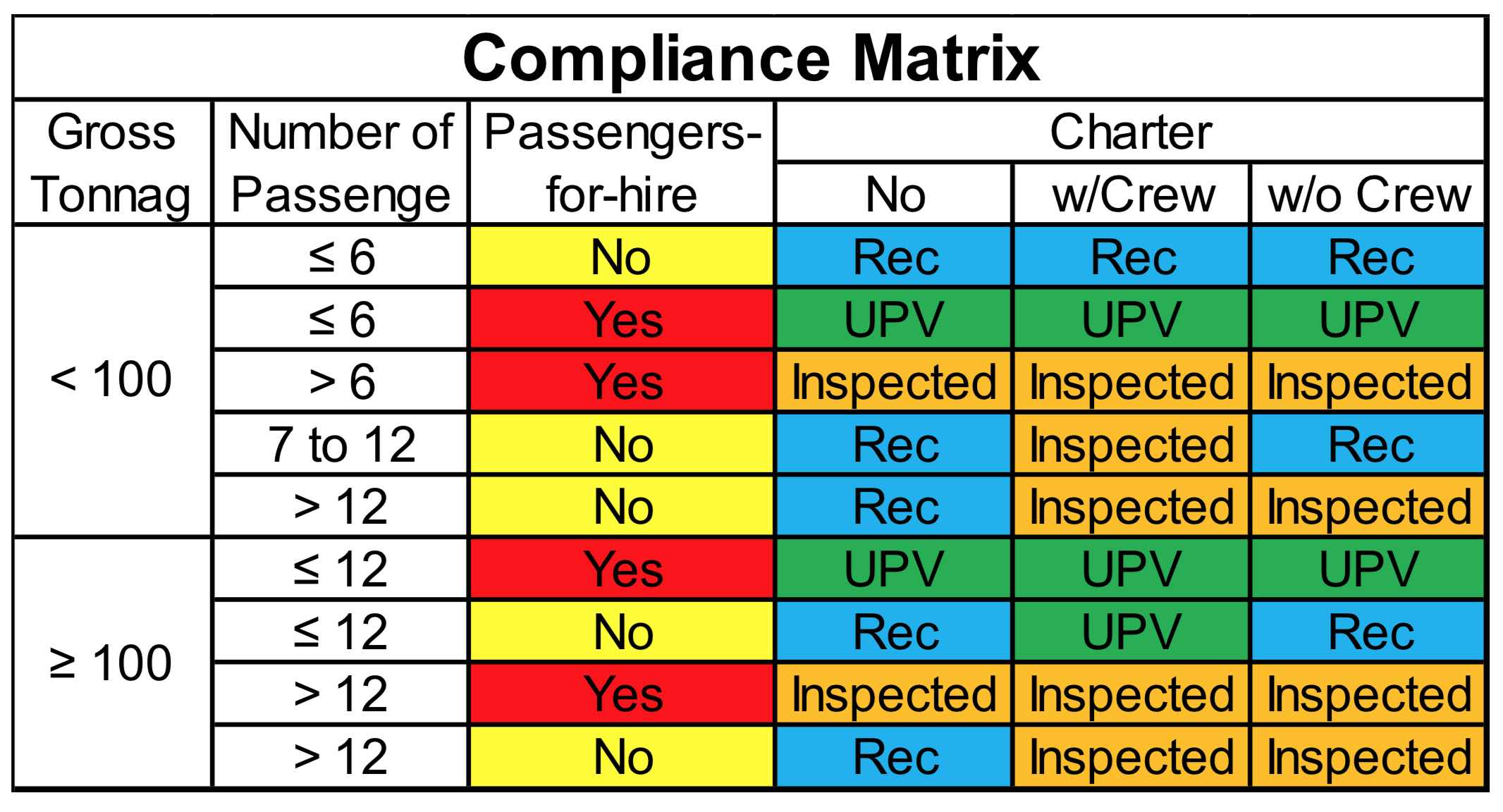Return to Flotilla 6-8's Home Page.

This page contains materials and job aids to assist you in performing VSCs, as well as to answer questions you may have regarding VSC requirements.
If there's concerns or questions you have that are not listed here, please contact Steve Fiorillo(FSO-VE), and your questions will be addressed and posted here to assist others.
Latest Flyers
Please print these out and take with you when conducting VSCs. These will be useful to hand out and use as you're walking the docks.
Topics
- Required Workshops
- 2025 VE Workshop
- The 2025 VE Workshop is now available. Once you've completed the workshop, complete the Self Assessment form and submit it to our FSO-IS along with the time it took you to complete the workshop for entry into AD2.
- You may find additional info on the VE & PV Member Training Page
- IMPORTANT: If this workshop is not completed by June 30, 2024 your VE status will be placed into REWK(RequiredWorkshop Not Met). If it is not completed by December 31, 2024, you will become REYR
- Latest Updates, Notices, & Amendments
- Reporting Time in AuxData II
- PFDs / Life Jacket Standards & Ratings
- ECOS - Emergency Cut-Off Switch
- Fire Extinguishers
- Inspection Requirements & Guidelines
- New Extinguisher Classifications
- Fire Extinguisher Requirements
- 2017 Kidde Recall Notice
- Reference Materials
- VE Training Materials: VE Manual, PWC Guide, Workshops
- Recreational Vessel VS Un-Inspected Passenger Vessel(UPV)

- CA Boater's Card Information
- CA Accident Report Form
- VSC Promotinal Materials Toolkit
- How to Request/Submit OpFac in AUXDATA II
- VSC Requirements by LOA
- New PFD Level Rating System
- Diverter Valve Reference Guide
- How to Handle A Boat Fire
- VSC Aids for Vessel Owner
- How To Register Your MMSI Number

- Frequently Asked Questions
- FEB, 2024: Fixed Fire Suppression System Inspection Update
- There has been recent reports that insurance companies have been voided insurance policies and as a result denying any claim, if the vessel owner has not maintained their onboard systems as expected, this includes regular inspection of the onboard fire suppression system(s).
As part of a VSC it is now more important than ever to emphasize to the owners that their fire suppression system is inspected on an annual basis by an authorized technician.
This suggestion does not conflict with the state regs for fire extinguishers and is only a curtesy to the owner. Again, if the system has not been inspected in the last five years and the vessel has additional fire extinguishers to meet their LOA requirement, then they pass on this item.
- MAY, 2022: New 7012 VSC Form
- This new form, though not yet available in carbon copy format, contains the new ECOS requirement under item 15e, as well as the new UL fire extinguisher ratings. Click here to download/print the latest 7012
- FEB, 2022: New Federal Law Change - Fire Extinguisher Expiration
- Effective April 20, 2022, a new Federal Law regarding the expiration of fire extinguisher stat that any fire extinguisher older than 12 years is no longer valid.
- This means any fire extinguisher, portable or serviceable, regardless of it's condition, is no valid if the expiration date on the bottom of the canister is more than 12 years.
- For more information please visit, https://wow.uscgaux.info/content.php?unit=v-dept or https://www.govinfo.gov/content/pkg/FR-2021-10-22/pdf/2021-22578.pdf
- FEB, 2022: VE Workshop Required for 2022
- The 2022 VE Workshop is now available. Once you've completed the workshop, complete the Self Assessment form and submit it to our FSO-IS, Steve Fiorillo for entry into AD2.
- IMPORTANT: If this workshop is not completed by June 30, 2022 your VE status will be placed into REWK(RequiredWorkshop Not Met). If it is not completed by December 31, 2022, you will become REYR
- MAR, 2021: New Engine Cut-Off Switch(ECOS) Requirements
- OCT 2020: SeaTow Discontinues their automated VHF testing Service. Refer to USCG MSIB 20-20:Performing a VHF Marine Radio Check on how to now conduct VHF radio test.
All the time you take to prepare, travel to, and perform a VSC needs to reported/recorded in AD2. However, your prep and travel time are separate from the actual exam time and must be recorded as such using the appropriate mission codes and different activity reports.
Recording Exam Time
Currently all VSCs can still only last 30 mins and need to be recorded as such. That said, you may record several VSCs for a single day or even a month on a single activity report as long as the total time for the report does not exceed 30min/VSC. For example, the duration time for reporting 3 VSCs at once can not exceed 1.5 hours, 4 VSCs at 2 hours, and so on.
The Mission Code used for VSC is 91A: Vessel Saftey Check. If you're reporting a paddle craft VSC, then the code is 91H: Paddlecraft Inspection
Recording Prep & Travel Time
As with the exam time, you may combine multiple VSC prep/travel time into one activity report to save time. There is no duration limit on this activity. The Mission Code used for recording this time is 99B: RBS Support.
In October, 2014, the Coast Guard announced the final rule to change the way PFDs are labeled, aligning our regulations with other global standards....
"The Coast Guard is issuing this final rule to remove references to type codes in its regulations on the carriage and labeling of Coast Guard-approved personal flotation devices (PFDs). Removing these type codes from our regulations will facilitate future incorporation by reference of new industry consensus standards for PFD labeling that more effectively convey safety information and is a step toward harmonization of our regulations with PFD requirements in Canada and in other countries."
Now that the new labeling system is starting to appear, it is important that we as VEs understand the new "Level" rating system and how it compares to the previous "Type" rating system.
New "Level" Rating System

New Rating System Icons
![]()
Download PFD Level Ratings job aid.
On April 1, 2021 a new federal law goes into effect that requires the operator of a boat with an installed Engine Cut-Off Switch (ECOS) to use the ECOS link. The link is usually a coiled bungee cord lanyard clipped onto the operator's person, Personal Flotation Device (PFD) or clothing and the other end attached to the cut-off switch, but there are plenty of variations on the market, including electronic wireless devices. The law applies on all "Navigable Waters of the US".
The following vessels are required to have an ECOS installed:
- Vessels < 26’ LOA
- If the engine produces 3hp or more
- Vessel was built on or after Jan 1 2020
- The primary helm is not in an enclosed cabin. Vessels where the primary helm is in an enclosed cabin are exempt from this rule
For more information please visit the USCG Boating Safety website - ECOS page.
Please Note: The new 2022 7012 form does have the ECOS requirement under "15e. Engine Cutoff Switch (ECOS)", however we have not been supplied with this new form and most likely will not be until inventory of the 2018 7012 form runs out. So in the meantime, please add "15e. ECOS" to your current 7012 form under the "Remarks" section noting either N/A, or YES/NO if they are required to have one as per above.
Fire Extinguisher Inspection Policy
There has been several questions regarding yearly inspection requirements. The following policy aligns with the current USCG, Federal, and NFPA guidelines.
Portable Disposable/Non-Rechargeable Fire Extinguishers:
Effective April 20, 2022:
All Disposable(Non-Rechargeable) Fire Extinguishers, regardless of condition, must be removed from service and are deemed non acceptable if they are older than 12 years from the expiration year stamped on the bottom of the canister.If units are 12 years or less than the expiration year, then they are acceptable only if the gauge is in the "green"; pin and zip-tie in tact; unit is free of damage, dents, or corrosion.
NOTE: It is highly recommended that all expired fire extinguishers be removed from the vessel. As these are "immediate ready to use items", you don't want to be reaching for something that may not work due to it being expired.
Click here to view new policy procedures. Further information can be found at https://wow.uscgaux.info/content.php?unit=v-dept
Portable Rechargeable Fire Extinguishers:
- Gauge must be in the "green"; pin and zip-tie in tact; unit is free of damage, dents, or corrosion.
- NFPA recommends a yearly inspection, though the AUX VSC Manual does not mention yearly inspections. A yearly inspection is therefore suggested, but not required to pass.
- Every six(6) years, the valve assembly needs to be removed and an internal inspected conducted. This is when the inspector “collars” the device with a round tag and cannot be applied unless they took the top valve off. See NFPA 10 Table 7.3.3.1
- Every twelve(12) years the device needs to be hydro-static tested and tagged as such. See Table 8.3.1 in NFPA 10
Fixed Fire Suppression Systems
- Gauge must be in the "green" if applicable (some do not have gauges).
- Unit is free of damage, dents, or corrosion.
- Every five(5) years an external inspection must be conducted and tagged as such.
- Hydro-static testing requirements depends on several factors: (1) steel vs aluminum tanks; (2) previous inspection results; and (3) discharging. As a rule of thumb if the unit is inspected every 5 years it will be up to the inspector to determine if a hydro-static test is required. See Marine Inspection Notice 02-12
- NOTE: If the fixed fire suppression system is being used to meet the minimal requirement count for the vessel's LOA and does not meet the above currency requirements, then a portable unit(10B:C) can be added to offset/replace the fixed system in the count and meet the LOA requirements. However, it is still recommended that the fixed system is certified ASAP and should be noted as such on the VSC exam form under the "Remarks" section.
Download VE Fire Extinguisher Inspection Policy
Additional references: Rechargeable Fire Extinguisher Memo
New Fire Extinguisher Rating System
On June 3, 2020, the USCG released a notice pertaining to the new fire extinguisher classification changes, dropping the previous Type I & Type II designations.
The new classification system complies with the UL-Listing standard and requires portable and semi-portable extinguishers to be marked with a combined number and letter designation. The letter designates the general class of fire for which the extinguisher is suitable and the number identifies either the water equivalent or square footage coverage area for that type of fire.
For example, a fire extinguisher may be labeled 4A:20B:C. The numbers indicate the size rating of each extinguishing agent. Here’s how it works:
- The Class A size rating represents the water equivalency. Each number represents 1.25 gallons of water. For instance, 2A means the extinguisher is just as effective as 2.5 gallons of water. 4A is equivalent to 5 gallons of water, and so on.
- The Class B size rating indicates the square footage the extinguisher can cover. 20B means that as long as you sweep the nozzle side to side, there is enough extinguishing agent inside the canister to provide 20 square feet of coverage. 30B covers 30 square feet, and so on.
- There is no size rating for Class C, as a Class C electrical fire is either a Class A or Class B fire with energized components. However Class C fires do require a non-conductive extinguishing medium, so if the unit is suitable for a Class C fire it will be noted accordingly, i.e. "B:C". To effectively fight Class C fires, choose your extinguishers based on the Class A and Class B size ratings.
- There is also no size rating for Class D fires. The effectiveness is detailed on the nameplate based on the specific combustible metal for which the extinguisher is recommended.
Fire Extinguisher Requirements
Acceptable Fire Extinguisher Classifications Based On Vessel Model Year
| Fire Extinguisher Type | Vessel Model Year | |
|---|---|---|
| Prior To 2018 | 2018 And Later | |
| 5-B:CC or Larger * | Acceptable | Acceptable |
| Type B-1 / Type B-II | Acceptable ** | Not Acceptable |
|
NOTES: * Must be replaced if > 12 years from date stamped on bottle ** Can remain in service > 12 years from date stamped on bottle if in "good and serviceable" condition |
||
Note Vessels model year between 1953 and 2017 may carry either 5‐B, 20‐B rated extinguishers with date stamp or B‐I/II rated fire extinguishers
Fire Extinguisher Requirements
|
NOTE - Vessel may carry only 5-B(10-B) or 20-B rated fire extinguishers with date stamp |
||
|---|---|---|
| Length In Feet |
Minimum number of 5-B(or 10-B) rated portable fire extinguishers required Note: One 20-B portable fire extinguisher may be substituted for two 5-B/10-B portable fire extinguishers. |
|
| No fixed fire extinguishing system in machinery space | Fixed fire extinguishing system in machinery space | |
| Under 16 | 1 | 0 |
| 16 but less than 26 | 1 | 0 |
| 26 but less than 40 | 2 | 1 |
| 40 up to 65 | 3 | 2 |
On November 2, 2017, Kidde issued a voluntary recall of two styles of disposable fire extinguishers that identified 142 models of Kidde fire extinguishers with plastic handles or push-button indicators manufactured between January 1, 1973 and September 22, 2017; these extinguishers can become clogged or require excessive force to discharge and can fail to activate during a fire emergency. In addition, the nozzle can detach with enough force to pose an impact hazard. The recalled extinguisher not only can be found on boats, but in homes, cars, airplanes, and other locations where a fire extinguished may be used. Click here to read the full memo.
Kidde Recall Notice 2017(Updated) View/Download
- VSC Manual M16796.8A: View / Download
- Amendment to VSC Manual M16796.8A - Change 1: View / Download
- Click How to Perfom VSC on a PWC to download the PowerPoint presentation.
- 2023 VE Workshop Presentation
Recreational Vessel VS Un-Inspected Passenger Vessel(UPV)
Un-Inspected Passenger Vessels(UPV) are types of commercial vessels that while they are used for "Passengers-For-Hire" and have to follow more restrictive guide lines than normal recreational vessels, are not subject to USCG Inspections due to there size and passenger load. However, like recreational vessels, it is recommended that they are inspected by USCG AUX UPV examiners(who are under USCG orders while conducting exams) so to ensure all UPV requirements are met.
UPV examinations can only be conducted by certified UPV Examiners and not a certified Vessel Examiners.
The main way to determine if the vessel is used for recreational or commercial use is (1) if the captain/owner specifies that the vessel is used for hired charters or (2) if there is a UPV decal present on the port side of the vessel. Examples of these types of vessels are small fishing charters, small whale watching charters, small sunset cruises, etc. The definition of "small" is determined by the gross tonnage(GT) of the vessel combined with passenger limitations...
- <100 GT & 6 or less passengers
- >=100 GT (most likely >65' LOA) and less than 12 passengers.
The exception to these rules are "bare-boat" charters or rental vessels(Duffy, PWC/Jet-ski, kayak, etc). A vessel can be rented/chartered out to a person and still remain as a recreational vessel as long as there are no captain/crew provided by the charter/rental company as part of the charter/rental fee. If the vessel comes with a captain/crew, then it is considered to be an UPV.
Please refer to the below reference matrix to determines if the vessel is Recreational, UPV, or Inspected vessel.
Click here to download this matrix.
Beginning January 1, 2018, operators of motorized vessels will be required to possess a California Boater Card.
Check below for required age group dates. By 2025, all persons who operate a motorized recreational vessel on California waters will be required to have one. Once issued, the card remains valid for a boat operator’s lifetime. California Harbors and Navigation Code Section 678.11(b) contains the following phase-in schedule based on operator age:
- January 1, 2024 Persons 60 years of age or younger
- January 1, 2025 All persons regardless of age
A violation of this article (Harbors and Navigation Code Section 678.15) is an infraction. Accordingly a person convicted of an infraction for a violation of this article shall be fined as follows:
- For an initial conviction, by a fine of not more than $100
- For a second conviction, by a fine of not more than $250
- For a third or subsequent conviction, by a fine of not more $500
CA Boating Accident Report Form(BAR)
This form should be discussed under VSC Item #14 State and/or Local Requirements.
This form is available in the centerfold of the ABCs of California Boating booklet. As the ABCs booklet may not always be available, we encourage that you download the BAR and have several copies with you to present to boaters during a VSC when needed.
The US Power Squadrons has complied a toolkit of promotional material for examiners to use as aides for boaters to promote VSCs. These materials can be found on the US Power Squadrons' Shared File Site.
This reference guide provides a quick look at some basic VSC requirements by vessel LOA for fire extinguishers, PFDs, VDSs, navigation lights, sound devices, ColRegs, and placards.
Click here to view/download reference guide.
This reference guide provides a quick look at the new "Level Rating" system for PFDs. It explains the difernt Levels, how they compare to the former "Type" ratings, and the new associated label icons .
Click here to view/download reference guide.
Diverter Valve Reference Guide
Diverter Valves are sometimes difficult to identify as they come in several shapes and sizes, but it's important to know what to look for and how they should be positioned to ensure they are closed when not in use.
Click here to view/download examples of diverter valves
One of the most terrifying things that can happen on a boat is a fire, and if you're not prepared it can lead to catastrophic results. When you conduct a VSC this would be a great hand out to provide to the vessel owners, as most probably never had to deal with a fire onboard.
Click here to view/download on the proper procedures to how to handle a fire onboard.
The following are materials and links that you can provide the vessel owners to help prepare them for their VSC, especially for those who have never been through a VSC or if it's been a while.
> VSC 7012 Form: This highlighted version provides the vessel owner with info highlight areas that are required, LOA specific, and specific to gasoline vessels. Click Highlighted VSC 7012 Form to download
> Performing a VHF Marine Radio Check: As of Oct 2020, SeaTow has discontinued their automated VHF testing service. You can provide the following document to boat operators on how to conduct a proper test of their VHF radio USCG MSIB 20-20:Performing a VHF Marine Radio Check
Registering Your VHF MMSI Number
A VHF MMSI (Maritime Mobile Service Identity) is a nine-digit number that uniquely identifies a vessel for DSC (Digital Selective Calling) radios. It's used for direct communication and emergency calls, transmitting over a DSC radio or AIS unit. To use your VHF radio's DSC functions, you must first program the unique MMSI number into the radio itself.
Download and print this instructional guide to pass out to vessel owners so that they may register their MMSI accordingly
Q: Which VSCs are considered to be "High Focus"?
A: A HIGH FOCUS VSC is defined as any vessel which meets one of the following criteria:
- "Length": <= 25'
- "Powered by" is Other
- “Type” is PWC or Other.
Q: Where can I can this year's VSC decals, 7012 forms, and/or hand-out materials?
A: There will be materials available at each month's Flotilla Meeting from the FSO-VE. If you missed the meeting, you can contact the FSO-VE, Steve Fiorillo to arrange pickup of materials. If there is something specific you're missing please contact the FSO-VE so they may be ordered accordingly.
Q: What are the Phase 3 requirements/protocols for conducting a VSC?
A: Click here to view the D11SR Phase 3 Rollout guidelines, and scroll down to the VSC section. Once you understand the protocols you must submit an Assignment To Duty(ATD) request, click here for the process.
Q: How do I submit an Assignment To Duty(ATD) request?
Q: Which Mission Code do I use to report VSC prep & travel?
